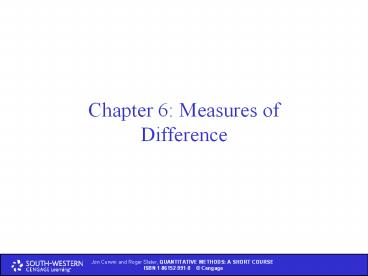Chapter 6: Measures of Difference - PowerPoint PPT Presentation
Title:
Chapter 6: Measures of Difference
Description:
Chapter 6: Measures of Difference Example Example Objectives Describe the differences in data using appropriate statistics Calculate the range and standard deviation ... – PowerPoint PPT presentation
Number of Views:97
Avg rating:3.0/5.0
Title: Chapter 6: Measures of Difference
1
Chapter 6 Measures of Difference
2
Objectives
- Describe the differences in data using
appropriate statistics - Calculate the range and standard deviation for
various types of data - Know when to use these measures of difference
3
Measures of dispersion
The main measures of dispersion are the standard
deviation, range and quartiles. The standard
deviation is an average of differences about the
mean. The range is the difference between the
largest and smallest values The quartiles are
quarter way and three quarter way markers
4
The mean is generally accepted as the mostly
commonly used statistics. It is useful to know
what is typical and the mean will allow us to
answer questions like what is the average age
and what was the average amount spent.
However, in most research we also want to know
about the differences and answer questions like
what age differences are there and how do
spending patterns vary.
5
- The types of data to be considered
- A simple list of numbers
- Tables of discrete data
- Tables of continuous data
6
Using a list of numbers
Example 5 salaries 6500 6500 6500 6500
10500
7
The mean is 7300
8
- The standard deviation is
- Regarded as the most important measure of
difference - Involves finding the difference about the mean
- Looks at the average size of these differences
9
Standard deviation is given by
Steps
1. calculate the mean
2. Calculate the deviations from the mean
10
3. square deviations
4. sum squared deviations
5. average squared deviations
which give variance
6. square root for standard deviation
11
Example
12
The range is just the difference between the
largest and smallest values
It is useful in giving an overview of the spread
in the data but it is very dependent on the two
most extreme (and often most unreliable) values
Range 10500 - 6500 4000
13
Using tables of discrete data
Example errors found in pages of print
14
To calculate the mean we divide the total
obtained from the last column and divided by the
total number of pages. (the mean has been rounded
to 2 d.p.)
15
(No Transcript)
16
to 2 d.p.
Rule of thumb most observations (95 making some
assumptions) are within /- 2 standard deviations
from the mean
17
Using tables of continuous data
When the tables give interval ranges, it is
necessary to use mid-points. Let x take the
mid-point values.
18
(No Transcript)
19
The mean
The standard deviation
20
Alternatively
21
(No Transcript)
22
Conclusions
- It is useful to have statistics that give both a
measure of location (typically the mean) and a
measure of spread (typically the standard
deviation - You have seen the calculation of the standard
deviation for different types of data - A spreadsheet or other computer package would
typically be used for such calculation































